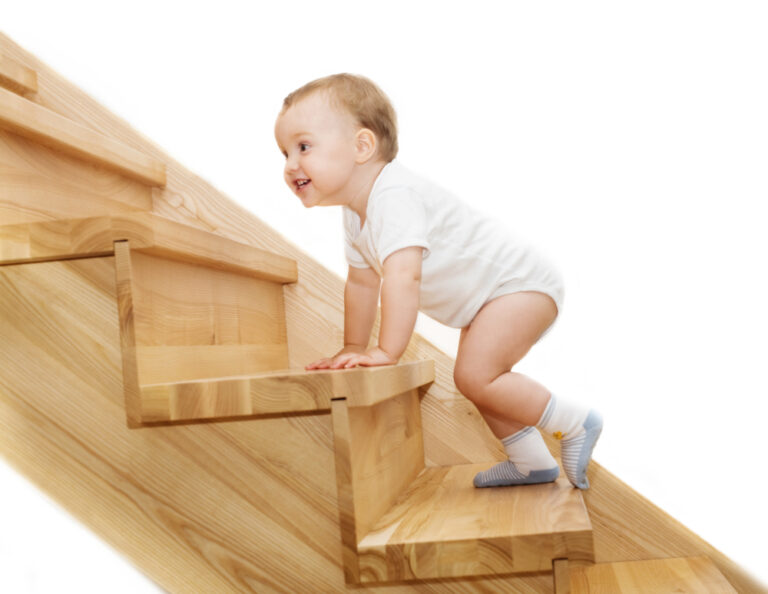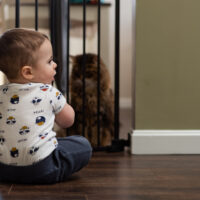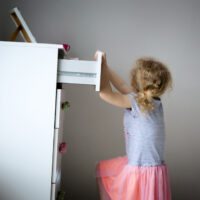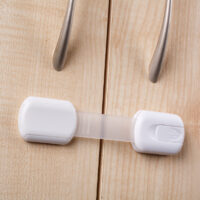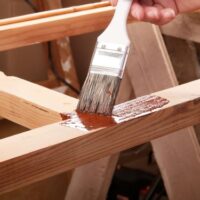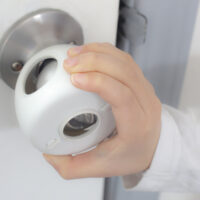The stairs are one of the many things you’ll need to baby-proof before your baby starts crawling. While baby gates are a great way to keep baby away, not all staircases are baby-gate friendly. Below, we’ll take a look at how to babyproof stairs without railing. Baby proofing your stairs is important to keep your child safe from falls. Falls are the most common non-fatal injury in kids. According to the CDC, nearly 2.8 million children are treated every year for falls- that’s around 8,000 emergency room visits per day.
Use a Baby Fence
The best baby fence for baby-proofing stairs has several segments and an adjustable shape. Instead of keeping your baby in, you can put it around the bottom of the stairs to keep your baby out.
Since you won’t be using all the panels, keep in mind that pressure-mounting isn’t going to work. You’ll need to have a baby gate that installs using mounting hardware on the wall.
You’ll need to position the baby gate on the walls beneath the stairs, as far back as necessary for the baby gate to fit. Mount the other side of the gate on the wall next to the staircase. Then, use as many panels as needed to wrap the baby gate around the base of the stairs so it keeps your little one out.
Use a Retractable Baby Gate
The major benefit of the best retractable baby gates is that they are easy for parents to open when necessary, but effective at keeping little ones safe. They are also a lot more compact than traditional baby gates. Rather than having to climb over the gate or swing it open, they roll up when you disconnect them from one side.
If you don’t have a traditional opening at the top of your stairs either, it might be best to use a baby gate like the one mentioned above. However, you will want to check manufacturer recommendations for larger play yards. Some manufacturers do not recommend using their product at the top of the stairs. Additionally, you should not pressure mount any baby gates at the top of the stairs because they may collapse or fall over with enough pressure.
Block Access to That Area
Sometimes, the best defense is keeping your baby out of the room/area that has the staircase. You can block the doorway or hallway that leads to the steps. This isn’t always practical (like when the stairs are in the living room and company is over) but you can limit baby’s access by keeping your baby inside a playpen, swing, or someone’s arms when you are leaving the room.
Other Steps You Can Take
Consider Installing a Railing
Handrails are installed as a safety measure for children and adults. At a minimum, you should have at least one hand railing that goes up the wall of the steps. If there aren’t any handrails at all in your home, installing one could prevent future accidents. For people who are renting, it is illegal in some locations to rent a property without a railing. It may be best to look into this or talk to your landlord about having one installed. Keep in mind that proper installation is important – a railing only provides more safety when installed correctly.
Carpet Your Stairs
Stairs that have finished wood, linoleum, and other smooth surfaces are most likely to cause falls. This is especially true if you’re wearing socks (or pants in the case of babies that crawl). Not only does carpeting provide traction for walking, but it also provides some padding. This means that if your child does fall, hopefully, they won’t get hurt as badly. If carpeting isn’t an option, reinforce that your child shouldn’t be running up or down the stairs with socks on. They should wear slippers with grips on the bottom or bare feet instead.
Keep Stairs Clear
Keeping your stairway clear also helps with safety. It’s a good practice that should be followed by everyone in the house. This means that stairs shouldn’t be cluttered with laundry or books sitting on the side, toys on the steps, or anything else. It can be very hard to see a small toy left on the middle of the steps, but it can be very easy to lose your balance on it. This is especially true if you’re carrying a laundry basket or something else that obstructs your vision.
Let Your Baby Practice (When They’re Ready)
As your baby gets better control over crawling (and even walking), it’s important that you get them familiar with the stairs. With children, it’s unlikely that telling them to stay off the steps is going to keep them away from your staircase. If anything, it might encourage them to move toward it more. This is especially true if you have to go upstairs for a minute and they are trying to follow you.
Instead of saying the steps are off-limits, teach your child how to use them safely. It’s important that you give your baby a chance to practice. This means if they do get curious one day, they’re less likely to get hurt.
The ideal place to practice is on carpeted steps. Stay nearby as you let your baby practice crawling on the steps. Teach them not to play and to stay focused. Instead of crawling down, you should also teach them to sit on the top of the stairs and scoot on their bottom.
Once your child is walking, teach them the importance of using the handrail. Even if their feet stumble, the handrail stops them from tumbling down when they grab onto it. If you don’t have one that is on the walled side of the steps, you should consider having one installed.
FAQs – How to Baby Proof Stairs without Railing
Do I need to baby-proof my stairs?
You should baby-proof your stairs as soon as your baby starts to move around on their own. Babies will be crawling before you know it, as well as pulling themselves up on things. The stairs are likely going to be something they’re curious about, so keeping them safe by baby-proofing your stairs is important.
While all children develop at their own rate, the best guideline is to install a baby gate around five months old. For some babies, this is around when they start crawling and moving around on their own.
Do I need a baby gate at the top and bottom of the stairs?
Yes, you should have a baby gate at the top and bottom of the stairs. While imagining your baby falling from the top of the stairs seems the most dangerous, babies that can crawl up the stairs may not be able to get safely down. This leaves them at risk of taking a tumble once they reach the top, especially if there is a baby gate in the way.
When can I stop using a baby gate on stairs?
You can stop using a baby gate on the steps when you feel confident in your child’s ability to safely navigate them. This usually happens around the toddler age (2-3 years). Being able to follow instructions (like walking and not running, always using the railing, etc.) is also important. Most children can retain rules like this as long as they are reinforced by this age, too.
You should also stop using a baby gate once your baby is trying to climb over them. In most cases, this won’t happen until the toddler stage.
Final Word
Even the most attentive parents are going to have to turn away to answer a phone call, make a bottle, or even just go to the bathroom. Taking these steps on how to baby-proof a staircase without railing will ensure your baby is safe even when you have to look away for a moment.
